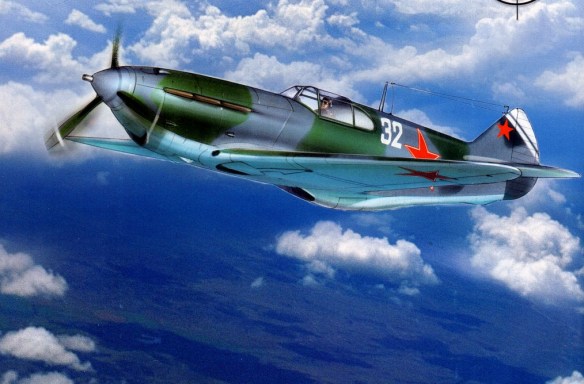The generation of combat aircraft built in the Soviet Union during the war witnessed the debut of designers who were to become world famous over the next few years. Following Mikoyan and Gurevich, another extremely talented technician was Semyon Alexseyevich Lavochkin, whose initials characterized a family of fighters that survived until the 1950s, ranging from the LaGG-1 of 1940, to the La-11 of 1947, the last aircraft powered by a piston engine to serve in the Soviet air force.
Lavochkin executed his first project together with another two talented technicians, Viadimir Petrovich Gorbunov and Mikhail lvanovich Gudkov, with whom he had worked since 1938. This was a single-seater fighter, initially designated I-22 and then LaGG-1; the prototype made its maiden flight on March 30,1940. The aircraft was a low-wing monoplane, carefully studied from an aerodynamic point of view and fitted with completely retractable landing gear. A predominant feature that made it unique among its kind, was its being built entirely in wood, with the exception of the moving parts, which were metal, and the fabric covering: the fuselage, empennage, and wings had a supporting structure in wood onto which a covering of diagonal strips of plywood was stuck using special resins. Its engine was a large Klimov M-105 liquid-cooled V-12 that generated 1,050 hp at takeoff.
However, flight tests proved to be unsatisfactory. Consequently, before production got under way, numerous modifications were carried out. These included the adoption of a more powerful and supercharged version of the Klimov M-105 engine (the 1,240 hp (925 kw) M-105PF) and of a three-bladed variable-pitch metal propeller, increased fuel tank capacity, and the installation of slats on the leading edge of the wings. The prototype was redesignated I-301 and, once tests had been completed, the fighter went into production with the official designation LaGG-3. However, its initial operative service (from 1941) brought to light some negative flight characteristics, for example, a tendency to go into a spin following particularly tight turns, making further research and testing necessary.
Lakirovanny Garantirovanny Grob—Varnished Guaranteed Coffin
Once in service with the units, the LaGG-3 was widely used in the early phases of the war against the Germans, especially on the Finnish front, and its performance proved to be satisfactory. However, the aircraft never possessed the characteristics of an interceptor that had been planned in the original project. Nevertheless, it was used with success in bomber escort duty, ground attack, and target attack against the least dangerous of the formidable German fighters, such as reconnaissance planes and bombers. Moreover, the LaGG-3 proved to be extremely versatile and reliable. Its typical armament included a 20 mm cannon that fired through the propeller hub and two 12.7 mm machine guns, while under the wings supports were planned for light bombs or rockets. Up to August 1942, a total of 6,528 LaGG-3s came off the assembly lines, a remarkable number considering the unexceptional performance of the aircraft.
In the course of production numerous other experimental prototypes were completed, built with the aim of improving the aircraft’s characteristics. Lavochkin, in particular, dedicated himself to the task of perfecting it. Following a series of failed attempts, success was achieved when a radically new engine became available. This was the Shvetsov M.82 radial engine and, once it had been fitted on the LaGG-3, it transformed it into a first-class aircraft, the LaGG-5 of 1942, one of the best Soviet fighters of the entire war.
Variants
Gudkov 82
Gudkov 37 (K-37)
Gorbunov 105 – A lightened LaGG-3 with improved performance and improved rear vision with cut down rear decking, overtaken by newer aircraft such as the La-5.
LaGG-3IT – LaGG-3 66 series with a NS-37 Cannon
Specifications LaGG-3 (data for LaGG-3 series 66)
General characteristics
Crew: One
Length: 8.81 m (28 ft 11 in)
Wingspan: 9.80 m (32 ft 1.75 in)
Height: 2.54 m (8 ft 4 in)
Wing area: 17.4 m² (188 ft²)
Empty weight: 2,205 kg (4,851 lb)
Loaded weight: 2,620 kg (5,764 lb)
Max. takeoff weight: 3,190 kg (7,018 lb)
Powerplant: 1 × Klimov M-105PF liquid-cooled V-12, 924 kW (1,260 hp)
Performance
Maximum speed: 575 km/h (357 mph)
Range: 1000 km (621 mi)
Service ceiling: 9,700 m (31,825 ft)
Rate of climb: 14.9 m/s (2,926 ft/min)
Wing loading: 150 kg/m² (31 lb/ft²)
Power/mass: 350 W/kg (0.21 hp/lb)
Armament
2× 12.7 mm (0.50 in) Berezin BS machine guns
1× 20 mm ShVAK cannon
6× RS-82 or RS-132 rockets up a total of 200 kg (441 lb)
